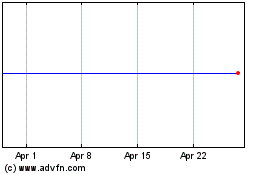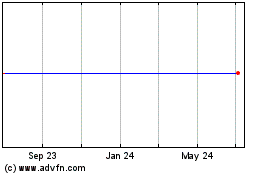FARXIGA Approved in the US for the Treatment of Heart Failure in Patients With Heart Failure With Reduced Ejection Fraction
May 06 2020 - 7:00AM
Business Wire
FARXIGA is the first SGLT2 inhibitor proven
to significantly reduce the risk of cardiovascular death and
hospitalization for heart failure
AstraZeneca’s FARXIGA® (dapagliflozin) has been approved in the
US to reduce the risk of cardiovascular (CV) death and
hospitalization for heart failure in adults with heart failure
(NYHA class II-IV) with reduced ejection fraction (HFrEF) with and
without type 2 diabetes (T2D).
The approval by the Food and Drug Administration (FDA) was based
on positive results from the landmark Phase III DAPA-HF trial,
which showed FARXIGA achieving a statistically significant and
clinically meaningful reduction of CV death or hospitalization for
heart failure, compared to placebo. The decision follows the
Priority Review designation granted by the FDA earlier this year
and the Fast Track designation granted in September 2019.
FARXIGA is the first sodium glucose co-transporter 2 (SGLT2)
inhibitor approved by the US FDA indicated to treat patients with
HFrEF (LVEF ≤ 40%).
Mene Pangalos, Executive Vice President, BioPharmaceuticals
R&D, said: “With the approval of FARXIGA, we have reached a
critical milestone to potentially transform heart failure treatment
for the millions of people living with the condition in the US. We
are now one step closer to making a significant impact on their
lives by providing a much-needed treatment to help reduce their
disease burden and live longer.”
John McMurray, MD, Cardiovascular Research Centre, Institute of
Cardiovascular and Medical Sciences, University of Glasgow, UK,
said: “The ground-breaking results of the DAPA-HF trial have
transformed heart failure therapeutics. Today’s approval provides
physicians with a completely novel pharmacological approach that
greatly improves outcomes for patients with heart failure with
reduced ejection fraction.”
The DAPA-HF trial showed that FARXIGA, in addition to standard
of care, reduced the risk of the composite outcome of CV death or
the worsening of HF versus placebo by 26% (absolute risk reduction
[ARR] = 5% [event rate/100 patient years: 11.6 vs 15.6,
respectively]; p<0.0001) in patients with HFrEF. During the
trial duration, one CV death or hospitalization for HF or an urgent
visit associated with HF could be avoided for every 21 patients
treated with FARXIGA.
The safety profile of FARXIGA in the DAPA-HF trial was
consistent with the well-established safety profile of the
medicine. The data from the DAPA-HF trial were published in The New
England Journal of Medicine.
In October 2019 the US FDA approved FARXIGA to reduce the risk
of hospitalization for HF in adult patients with T2D and
established CV disease or multiple CV risk factors. The approval
was based on the DECLARE-TIMI 58 trial.
FARXIGA is also indicated as an adjunct to diet and exercise to
improve glycemic control in adults with T2D.
INDICATIONS AND LIMITATIONS OF USE for FARXIGA®
(dapagliflozin)
FARXIGA is indicated:
- as an adjunct to diet and exercise to improve glycemic control
in adults with type 2 diabetes mellitus
- to reduce the risk of hospitalization for heart failure in
adults with type 2 diabetes mellitus and established cardiovascular
(CV) disease or multiple CV risk factors
- to reduce the risk of cardiovascular death and hospitalization
for heart failure in adults with heart failure (NYHA class II-IV)
with reduced ejection fraction
FARXIGA is not recommended for patients with type 1 diabetes
mellitus or for the treatment of diabetic ketoacidosis.
IMPORTANT SAFETY INFORMATION for FARXIGA® (dapagliflozin) 5
mg and 10 mg tablets
Contraindications
- Prior serious hypersensitivity reaction to FARXIGA
- Patients with severe renal impairment (eGFR <30 mL/min/1.73
m2) being treated for glycemic control without established CV
disease or multiple CV risk factors
- Patients on dialysis
Warnings and Precautions
- Volume Depletion: FARXIGA can cause intravascular volume
depletion which may manifest as symptomatic hypotension or acute
transient changes in creatinine. Acute kidney injury requiring
hospitalization and dialysis has been reported in patients with
type 2 diabetes receiving SGLT2 inhibitors, including FARXIGA.
Patients with impaired renal function (eGFR less than 60
mL/min/1.73 m2), elderly patients, or patients on loop diuretics
may be at increased risk for volume depletion or hypotension.
Before initiating FARXIGA in these patients, assess volume status
and renal function. After initiating therapy, monitor for signs and
symptoms of hypotension and renal function
- Ketoacidosis in Diabetes Mellitus has been reported in
patients with type 1 and type 2 diabetes receiving FARXIGA. Some
cases were fatal. Assess patients who present with signs and
symptoms of metabolic acidosis for ketoacidosis, regardless of
blood glucose level. If suspected, discontinue FARXIGA, evaluate
and treat promptly. Before initiating FARXIGA, consider risk
factors for ketoacidosis. Patients on FARXIGA may require
monitoring and temporary discontinuation in situations known to
predispose to ketoacidosis
- Urosepsis and Pyelonephritis: SGLT2 inhibitors increase
the risk for urinary tract infections (UTIs) and serious UTIs have
been reported with FARXIGA. Evaluate for signs and symptoms of UTIs
and treat promptly
- Hypoglycemia: FARXIGA can increase the risk of
hypoglycemia when coadministered with insulin and insulin
secretagogues. Consider lowering the dose of these agents when
coadministered with FARXIGA
- Necrotizing Fasciitis of the Perineum (Fournier’s
Gangrene): Rare but serious, life-threatening cases have been
reported in patients with diabetes mellitus receiving SGLT2
inhibitors including FARXIGA. Cases have been reported in females
and males. Serious outcomes have included hospitalization,
surgeries, and death. Assess patients presenting with pain or
tenderness, erythema, swelling in the genital or perineal area,
along with fever or malaise. If suspected, institute prompt
treatment and discontinue FARXIGA
- Genital Mycotic Infections: FARXIGA increases the risk
of genital mycotic infections, particularly in patients with prior
genital mycotic infections. Monitor and treat appropriately
Adverse Reactions
In a pool of 12 placebo-controlled studies, the most common
adverse reactions (≥5%) associated with FARXIGA 5 mg, 10 mg, and
placebo respectively were female genital mycotic infections (8.4%
vs 6.9% vs 1.5%), nasopharyngitis (6.6% vs 6.3% vs 6.2%), and
urinary tract infections (5.7% vs 4.3% vs 3.7%).
Use in Specific Populations
- Pregnancy: Advise females of potential risk to a fetus
especially during the second and third trimesters
- Lactation: FARXIGA is not recommended when
breastfeeding
DOSING
- To improve glycemic control in patients with T2D, the
recommended starting dose of FARXIGA is 5 mg orally once daily,
taken in the morning. In patients tolerating FARXIGA 5 mg once
daily who require additional glycemic control, the dose can be
increased to 10 mg once daily
- To reduce the risk of hospitalization for heart failure in
patients with T2D and established CV disease or multiple CV risk
factors, the recommended dose of FARXIGA is 10 mg orally once
daily
- To reduce the risk of CV death and hospitalization for heart
failure in patients with HFrEF, the recommended dose of FARXIGA is
10 mg orally once daily
Please see accompanying US Full Prescribing Information and
Medication Guide for FARXIGA.
Notes
Heart failure
HF is a life-threatening disease in which the heart cannot pump
enough blood around the body. It affects approximately 64 million
people worldwide (at least half of which have a reduced ejection
fraction) and six million in the US. It is a chronic disease where
half of patients will die within five years of diagnosis. There are
two main categories of HF related to ejection fraction (EF), a
measurement of the percentage of blood leaving the heart each time
it contracts: HFrEF and heart failure with preserved ejection
fraction (HFpEF). HFrEF occurs when the left ventricle (LV) muscle
is not able to contract adequately and therefore, expels less
oxygen-rich blood in to the body. HF remains as fatal as some of
the most common cancers in both men (prostate and bladder cancers)
and women (breast cancer). It is the leading cause of
hospitalisation for those over the age of 65 and represents a
significant clinical and economic burden.
DAPA-HF
DAPA-HF (Dapagliflozin And Prevention of Adverse-outcomes in
Heart Failure) is an international, multi-center, parallel-group,
randomized, double-blinded trial in 4,744 patients with heart
failure and reduced ejection fraction (LVEF ≤ 40%), with and
without T2D, designed to evaluate the effect of FARXIGA 10mg,
compared with placebo, given once daily in addition to standard of
care. The primary composite endpoint was time to the first
occurrence of a worsening heart failure event (hospitalization or
equivalent event; i.e. an urgent heart failure visit), or
cardiovascular death. The median duration of follow-up was 18.2
months.
AstraZeneca in CV, Renal & Metabolism (CVMD)
CV, renal and metabolism together form one of AstraZeneca’s main
therapy areas and a key growth driver for the Company. By following
the science to understand more clearly the underlying links between
the heart, kidneys and pancreas, AstraZeneca is investing in a
portfolio of medicines to protect organs and improve outcomes by
slowing disease progression, reducing risks and tackling
co-morbidities. Our ambition is to modify or halt the natural
course of CVMD diseases and potentially regenerate organs and
restore function, by continuing to deliver transformative science
that improves treatment practices and CV health for millions of
patients worldwide.
About AstraZeneca
AstraZeneca is a global, science-led biopharmaceutical company
that focuses on the discovery, development and commercialization of
prescription medicines, primarily for the treatment of diseases in
three therapy areas - Oncology, Cardiovascular, Renal &
Metabolism and Respiratory. AstraZeneca operates in over 100
countries and its innovative medicines are used by millions of
patients worldwide. For more information, please visit
www.astrazeneca-us.com and follow us on Twitter @AstraZenecaUS.
View source
version on businesswire.com: https://www.businesswire.com/news/home/20200506005282/en/
Media Inquiries Michele Meixell +1 302 885 2677
AstraZeneca (NYSE:AZN)
Historical Stock Chart
From Mar 2024 to Apr 2024

AstraZeneca (NYSE:AZN)
Historical Stock Chart
From Apr 2023 to Apr 2024
